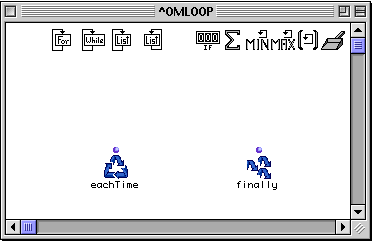OpenMusic Reference
omloop

omloop
(control module) -- a multipurpose function for writing program loops
Syntax
omloop &rest input
Inputs
omloop takes as many inputs as needed. They are added with the usual keystroke combination option –>. They will accept any data type, provided that the functions inside the loop accepts the type.
Output
Outputs are added to omloop as needed from inside the omloop window by adding inputs to the finaldo function with the key combination option –>.
Description
omloop is a special form of generic function performing tasks which require repetitive procedures. These procedures fall broadly into two categories: iteration and accumulation. Iteration involves stepping through a list of elements, either elements of a list or a range of values for a variable, and doing something with the data. Accumulation is often performed at the same time, meaning that the results of the calculations are collected in a list, or grouped and processed in some other way.
Double-clicking the function icon opens a patch window:

The functions available in omloop are all documented on their own reference pages in this section of the Users’ Manual.
You can see that two special icons have already been placed automatically: loopdo (eachTime) and finaldo (finally) . These functions are necessary to make omloop function and cannot be deleted.
Along the top are icons representing the rest of the various kinds of iterative and accumulative functions available within omloop . These functions are restricted to use within the omloop patch box; they cannot be moved into a normal patch window, though they can be dragged or copied to other omloop boxes. All other standard OM and LISP functions can be used within the patch window as well.
omloop does not have any inputs by default. Inputs are added by clicking the omloop icon and using option –>. Inputs will then appear inside the patch window.
omloop has one output by default. Inside the patch window, this output is represnted by the finaldo (finally) function icon. Adding additional inputs to finally adds outputs to the omloop icon itself.
omloop ‘s output depends on the choice of iterators, accumulators and output functions. Multiple iterators and accumulators can be used simultaneously. The number of possible procedures is thus virtually unlimited.
The basic idea behind omloop
The number of combinations of functions within omloop is quite large, making it impossible to give a single example of its operation that is general enough to cover all cases. One can, however, explain the basic concept.
In general, a process is repeated as long as certain conditions are met. The results are then collected and returned. Controlling the conditions for repetition is done by the iterator functions. They are the group of icons on the upper-left of the omloop patch window. Iterators might pass each of the values of a list individually, or might allow the loop to repeat as long as a certain predicate returns t. All omloop patch windows must have at least one iterator. Otherwise the loop will execute forever!
The results are collected by collector functions. They are in the upper- right corner of the patch window. They may simply collect the results of the repeated calculations into a list, or may count the number of times a certain result is produced, or add the results of all the calculations together.
The repeated task is accomplished by linking the functions performing the task to loopdo (eachTime) and finaldo (finally) . The eachTime function (and therefore, everything connected to it) is evaluated on every repetition save the last. Connecting it to the collectors triggers them and makes them function each time the loop executes. The function finally (and therefore, whatever is connected to it) is evaluated on the last repetition of the loop. It is usually connected to a collector to pass the results of the collection to the output of omloop . Note that additional post-processing functions can be put between finally and the collector to perform some task on the results of the collection.
The repeated function itself- the task performed on the data- is performed by everything else in the box.
The following are the special omloop functions. See their reference pages for more details:
Iterators
-
forloop - Steps through a series of numeric values. When a threshold is reached, loop execution stops.
-
whileloop - Allows repetition (iteration) to continue as long as a predicate returns t.
-
listloop - Causes one repetition for each element of a give n list.
-
onlistloop - Causes one repetition for each element of a give n list, but passes cdrs of the list.
Collectors
-
counter (count) - Counts the number of times a given value is non-nil.
-
sum - Returns the sum of the collected elements.
-
minim (min) - Returns the minimum value of its collected elements.
-
maxi (max) - Returns the maximum value of its collected elements.
-
listing (collect) - Collects the result of each repetition into a list.
-
accumulator (accum) - A generalized customizable accumlator.
Outputs
-
loopdo (eachTime) - Triggers the repetition.
-
finaldo (finally) - Returns the result of the loop.
| Prev | Home | Next |
|---|---|---|
| omloop and Components Reference | Up | forloop |